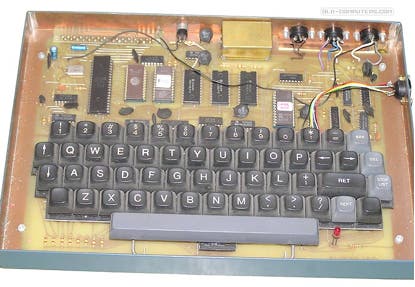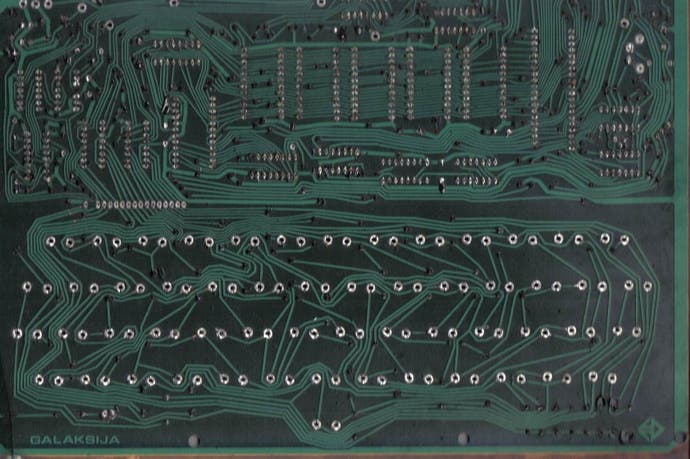The story of Yugoslavia's DIY computer revolution
Meet Galaksija, the wooden wonder computer.
In Yugoslavia in the 1980s, computers were a rare luxury. A ZX Spectrum or Commodore 64 could easily cost a month's salary, and that's if you could even get through the tough importation laws. Then in 1983, while on holiday in Risan, Voja Antonić dreamt up plans for a new computer, a people's machine that could be built at home for a fraction of the cost of foreign imports. The Galaksija was born, and with it a computer revolution.
"In 1983, hardly anyone knew what computers were for or how they looked," says Antonić. At the time, the only computer that most people in Yugoslavia would ever come across would be a programmable calculator, but things were changing fast. Antonić had already been messing around with microprocessors for several years, but the huge expense of ready-built machines drove him to make his own: "I liked to play around with Z80 microprocessor projects, mostly for controllers and computer animation. But computers were too expensive for me, so I had to make my own. One of those computers was so simple and easy to make that I thought that maybe someone else would wish to make it themselves."
"My friend Dejan Ristanović and I spent a lot of days and nights brainstorming while I was writing Galaksija's operating system. I had to walk outside sometimes just to dissolve the adrenaline rush."
Voja Antonić

By the time he returned from holidaying on the Montenegro coast in the summer of 1983, Antonić had already sketched out some conceptual diagrams of the new machine. The core of the computer would be a Zilog Z80 microprocessor, a cheap and widely available chip that was also at the heart of the Sinclair ZX Spectrum. In terms of computing power, though, Antonić's brainchild was more in the range of the earlier Sinclair ZX81, although "with a better keyboard" notes the inventor, in a sly dig at the notoriously difficult to use membrane keyboard of the ZX81.
The operating system was also, in Antonić's words, "more friendly" than the ZX81's, an example of which was its charmingly simple error messages. 'WHAT?' popped up in the case of a syntax error, 'HOW?' appeared if the requested input was theoretically impossible, and users received a 'SORRY' if the operation exceeded the system limitations. If only Windows was as transparent and polite.
The rest of the Galaksija was similarly basic. "It had a 32x16 text mode and very rough 64x48 block graphics," recalls Antonić. "The arithmetic routines were previously 'stolen' from TRS Level 1 Basic and the rest was originally written. Later I added my own arithmetic routines with many more functions, as well as the Z80 assembler and disassembler." Importantly, despite its limitations, it was cheap, and for many Yugoslavians it would be the first computer they would ever own.
With the concept in place, the next step was distribution. Antonić's plan was to make the diagrams for the machine freely available, and by a happy coincidence a popular Yugoslavian science magazine - Galaksija (pronounced 'Galaxiya', 'Galaxy' in English) - was at that time planning a spin-off publication aimed at home computing. The name of the magazine eventually became twinned with the name of the computer, but the spin-off publication that formed the bible of the Yugoslavian computer movement was named Računari u vašoj kući ('Computers in Your Home').

"It would be pretty immodest to say that the 100-page publication 'Računari u vašoj kući' set off the computer revolution in Yugoslavia," states Dejan Ristanović, author of the magazine. "So I won't say it; the fact is, however, that the computer revolution began just after the appearance of the first issue of the 'Računari' magazine. Clearly, the time and the circumstances were favourable, and the well advertised publication only gave things a push in the right direction..."
Voja Antonić recalls the heady days that led up to December 1983 and the release of the first issue of Računari, which contained detailed plans on how to build your own Galaksija computer. "My friend Dejan Ristanović and I spent a lot of days and nights brainstorming while I was writing Galaksija's operating system." says Antonić. "I had to walk outside sometimes just to dissolve the adrenaline rush."
After months of hard work the magazine was released into the world, and with it the DIY plans for the Galaksija. Antonić remembers speculating on the reception the computer would receive soon after Računari issue one was put to bed: "It was in December 1983 when three of us - magazine author Dejan Ristanović, editor Jova Regasek and me - finished the job and were sitting in the editorial office, talking about how the new magazine would be accepted by the audience. Jova asked for our opinion on how many readers would make the computer, and I said that I would be satisfied if the number reaches 50. Dejan said that it would be at least 100, and Jova said, 'Don't be a fool, there will be at least 500'. We laughed at him, but a few months after that we received more than 8,000 letters from readers who had made their own Galaksijas."
The machine proved to be a success far beyond its creator's imagination, and readers clamoured to get their hands on the plans contained within the inaugural issue of Računari. "It was an unbelievable success," remembers Ristanović. "The people who bought the magazine were very interested in computers but knew almost nothing about them. The circulation of 30,000 copies was sold out in a matter of weeks, so we printed another one of the same size. Finally, we printed a third edition of 40,000 copies which sold out as well, even though two other issues of 'Computers' had appeared in the meantime."
"I had to inform the Radio Belgrade technicians who were on duty at remote radio transmitters that for the next few minutes only hissing and growling would be heard."
DJ Zoran Modli

One quirk of the Galaksija computer was that even in the kit form that was sold by Antonić and his colleagues, it didn't have a case. Users were expected to build their own case for the machine, which meant that no two Galaksijas ever looked alike. Some enthusiasts built elaborate, burnished silver cases, whereas others plumped for more basic designs. "Most of them made it of wood," says Antonić, "but some Galaksijas remained naked for their whole lifetime."
Like the ZX Spectrum and other computers of the time, programs were loaded onto the Galaksija from an audiocassette recorder. This gave Jova Regasek, the editor of Računari, an idea for a bold experiment. He got in touch with Zoran Modli, who hosted the show Ventilator 202 on Radio Belgrade. Modli's show was a mix of local bands and contemporary chart music, but he also had an interest in computers, and Regasek's idea was to broadcast the sound of a computer program that listeners could tape and then load up on their home machines. In effect, this was wireless downloading long before the days of wi-fi.
"Both me and my radio team were very excited," remembers Modli. "I wondered whether the audience would understand what it was. I had to inform the Radio Belgrade technicians who were on duty at remote radio transmitters that for the next few minutes only hissing and growling would be heard. 'Do not worry, it's not the fault of the broadcast. I'm doing that intentionally and it is sound code of computer programs I intend to broadcast!'"
Modli warned his listeners to be ready with their cassette recorders, then waited to see the response after he played the screeching and wailing tape into the ether. Soon he began receiving excited calls from his audience, who said they'd been able to load the program - a routine called 'Paginator' - onto their computers. But not everyone was impressed, notably the station heads. "They thought it was a scandalous event!" says Modli. "I had a big problem explaining to them that it was a revolution in radio and they should be proud."

Over the next three years, Ventilator 202 went on to broadcast over 150 programs for the Galaksija, ZX Spectrum and Commodore 64, most of which had been programmed and sent in by keen listeners. "These were mostly useful routines for everyday use," says Modli, "programs for mathematical calculations, short educational programs, mini-encyclopedias, simple games, and for a few months we even used to prepare and issue digital newspapers named 'Hack News'." The Yugoslavian computer revolution was well under way.
The Galaksija continued its run of success for many years, and eventually it became commercially available. Many educational institutions received one, and it was even used to teach computer science in elementary schools. Eventually though, it fell into obscurity, and even its inventor discarded his creation. "I had five functional Galaksija prototypes, but at some time in 1995 I threw them all on the dump," recalls Antonić in a statement that would shock today's collectors. "Simply, nobody was interested in such old things any more, including me."
Thankfully, that's not quite the end of the story though. "Just a few years after that, old-computer nostalgia was born and I found one forgotten Galaksija in my cellar. I was asked to give it to the Museum of Science and Technology in Belgrade: now it's part of the exhibition."

